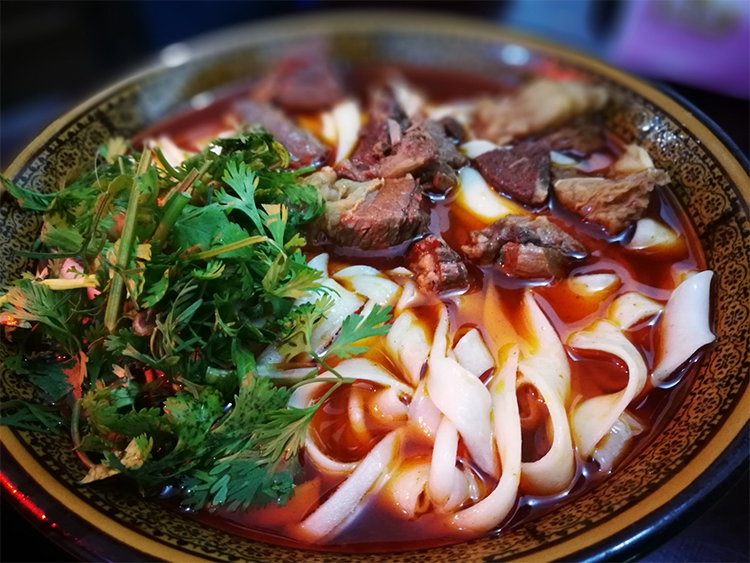Ya’an Tatta Noodles: Sichuan’s Dance of Dough
1. Ya’an Tatta Noodles: A Bowl That “Dances”
Beyond Sichuan’s famous hotpot and mapo tofu lies a lesser-known but deeply soulful noodle tradition in Ya’an, a rainy city in western Sichuan. Known locally as Tatta noodles or Ta Ta noodles, the name evokes the sharp, rhythmic sound made when dough is slammed on the wooden board during preparation. More than a comforting meal, Tatta noodles are a sensory performance—a blend of strength, craftsmanship, and cultural memory that forms an essential part of daily life in Ya’an.
2. Historical Echoes: From the Tea-Horse Road to Local Tables
Ya’an, historically called Yazhou, was a key starting point of the Tea-Horse Road linking Sichuan with Tibet. Tatta noodles are believed to have developed to meet the needs of caravan porters and traders who required a filling, portable, and long-lasting staple. The vigorous pounding and stretching technique created noodles that stayed firm and chewy after cooking—perfect for travelers.
Over centuries, Tatta noodles moved from waystations and teahouses into neighborhoods across Ya’an. What began as sustenance for the road has become a regional specialty, full of nostalgia. Many family-run noodle shops hand down recipes and skills through generations; the steady “tatta” rhythm is a living echo of the past.
3. Ingredients and Broth: The Foundation of a Great Bowl
The quality of a Tatta noodle bowl depends on humble, carefully selected components:
- Noodle core: High-gluten wheat flour, water, and a small amount of alkaline agent (often traditional plant-ash lye) produce the noodle’s pale yellow color, distinctive aroma, and extra chew. The traditional method—mixing flour, water, and alkali and then repeatedly kneading and beating—creates a resilient dough known locally as the “three-part dough.”
- Broth essence: The soup is the noodle’s stage. Typical Tatta broths simmer pork bones, chicken frames, or duck bones for hours over low heat until the liquid turns milky and richly savory without feeling greasy. A spoonful of this broth complements the chewy noodles and balances their texture.
4. A Visual Art: The Hand-Beaten Noodle Technique
Watching a master make Tatta noodles is like watching a culinary performance. Dough is rolled into thick ropes, then grabbed by the ends and raised high before being slapped onto the board in a steady rhythmic sequence—”pa! pa! pa!”—which both tightens gluten strands and stretches the dough. Between the slaps, the dough is pulled to length and then broken to the desired width. The result is a noodle with maximum chew and resilience, created through a seamless dance of force and finesse.

5. Flavor Varieties: A Topping Kaleidoscope
Tatta noodles come with an array of toppings to suit diverse tastes:
- Braised beef Tatta: Large chunks of slow-braised beef in a savory, slightly spicy sauce. The rich meat contrasts beautifully with the springy noodles.
- Minced meat sauce (zha jiang): Pork mince stir-fried into a fragrant, slightly spicy sauce that clings to every strand.
- Three-fresh (san xian): A lighter option featuring ingredients like pork liver, lean pork slices, and crisp fried bites—ideal if you want the broth and noodle texture to shine.
Other shops may offer chicken, pork rib, or house-special sauces—each family-run shop often has its signature topping to discover.
6. How to Eat Like a Local: Tasting Tips
- Sip the broth first: Start with a spoonful of the clear, milky broth to appreciate its depth.
- Mix well: Combine toppings, sauce, and noodles so every strand is coated.
- Slurp with confidence: Locals eat Tatta noodles with gusto—slurping enhances the texture and aroma and is part of the experience.
- Pair with pickles: Most noodle stalls provide quick-pickled vegetables. The bright acidity refreshes your palate and balances the rich soup.
7. Traveler Tips: Finding the Most Authentic Tatta Noodles
To taste genuine Tatta noodles, look beyond fancy restaurants. The best bowls often come from humble, busy street-side shops beloved by locals—so-called “fly restaurants” that focus on flavor rather than décor. Ask hotel staff or taxi drivers for recommendations to locate long-established shops. Tatta noodles are eaten for breakfast, lunch, or even late-night snacks; many shops open early and close when they sell out. If you’re sensitive to spice, ask for “no spice” or “mild spice”—the broth itself remains flavorful even when not spicy.
Ya’an is also a gateway to panda reserves and scenic sites like Bifeng Gorge and Mengding Mountain. A sturdy bowl of Tatta noodles is the perfect meal before or after exploring these attractions.
8. Home Attempt: A Simplified Tatta Noodle Recipe
You can try a basic version at home to experience the dish’s character. Use high-gluten flour and a pinch of baking soda if you can’t find traditional alkaline water. Knead a firm dough, let it rest, then roll and cut into strips. Simulate the pounding by stretching and lightly slapping small batches on a clean board. For broth, simmer pork or chicken bones in a pressure cooker for a quicker, rich stock. Top with simple minced pork sauce or braised beef.
9. Conclusion
A steaming bowl of Ya’an Tatta noodles is more than a meal—it’s a taste of history and a touch of local life. As you travel through Sichuan, between panda reserves and mountain trails, don’t miss a chance to join locals in savoring this hand-made, intensely textured noodle and the warm stories it carries.


